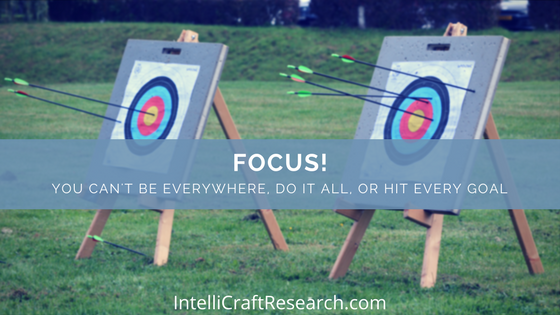What Are the Goals of Content Marketing

Do you know what the goals of content marketing are?
Let’s talk about a few tough questions. Questions that get to the fundamentals of content marketing, or really ANY aspect of marketing – questions about goals. Maybe you’ve been intrigued by past posts of mine talking about how content marketing DOES make sense for libraries and similar nonprofits. Maybe you’ve seen one of my many presentations or webinars where I talk content strategy or how you’re closer to doing content marketing than you think. You and your library are already all over social media and improving your website – but want to know how this all really ties together. So, let’s go to the beginning, and talk goals.
Do your content goals match your overall marketing goals?
Do your content goals match your organization’s overall goals?
Content needs to align – and it needs to help your organization while it helps your audience. Think of content as the missing puzzle piece – but you need all the other pieces too!
You may not have all the info or data you need to make decisions on goals and objectives – that’s probably true for your whole marketing plan. So make your best educated guesses based on all you DO know, what you can find out, what fits your bigger plans – and then test it.
That’s how marketing works – test, test, test. Tweak, tweak, tweak.
Ask yourself or your team (if you’re lucky to have one!) some serious questions before you get started – you’ll be more successful :
- Why are you communicating with your particular audience in the first place?
- What are you trying to do with your marketing communications overall?
- What are you trying to achieve with this specific piece of content, or format of content?
For nonprofits, for example, are you trying to build community? [and what does that really mean for you??]
- Are you building your nonprofit organization’s brand?
- Are you fundraising?
- Are you trying to attract new volunteers?
- Are you all about event attendance?
Time to Ask Some Tough Questions About Our CM Goals

Think about the specifics of what you’re shooting for in your organization and with your outreach and marketing efforts – then you can start thinking about what certain content platforms or pieces should aim to do for you.
- What does “success” look like for your organization?
- Have you determined your big picture success definition?
- What is your definition of successful marketing objectives?
- Now, think about what it would mean to be “successful” with this particular piece of content?
-
- This PDF?
- That video?
- Those weekly emails?
- Your series of blog posts on X topic?
- The print newsletter you still have?
- Your social media posts, your Pinterest pins, your Tumblr?
-
I never said content strategy and content marketing were easy! Or should I say, “effective, strategic content marketing isn’t easy or quick.” Just throwing a lot of library related materials on social media is NOT content marketing. You know that. And thinking about what “success” means, what your goals are, for EACH channel and EACH piece of content is hard work. If that means cutting down on the platforms or channels you use, so be it! But asking these questions, setting goals, and evaluating the purpose of your content is necessary. It makes for integrated marketing, which is so much more powerful and effective – and sustainable – when you have your goals set, plans outlined, calendars working, and tools in place.
NOTE: I’m digging into how content marketing is about attraction, not interruption as well as making it the engine to drive your marketing cycle at #LMCC17 in Dallas in November. Will I see you there? Check back for more related tips and resources.
Some content marketing goals are broader than others –
Engage
Educate
Inform
Entertain
Yes, all of those are potential goals for your content marketing strategy and may apply to different channels even (e.g. social media vs. a blog vs. video site). You will need to drill down a bit further and decide what ‘engagement’ looks like for you and your audience.
What might “educate” mean?
- 3 ‘how-to’ posts w/ links and ~ 800 words per month?
- One 8 minute ‘how-to’ video?
- Only curating tweets that come from educational sources related to educating your audience about your given topic?
- Giving mini-courses on an aspect of your core topic(s)?
- Producing 1 purely educational video per month or per quarter?
And think about how you might know (or figure out) if your audience is actually becoming ‘educated’ about your topic.
Now, go through that same exercise for other common reasons org’s use content marketing: What does “engage” mean and look like for your library? What does it mean for you to “entertain” with content marketing? How does “inform” look different than “educate”?
More specific goals of content marketing often include:
-
- Building/improving placement in search results
- Building word of mouth and referrals
- Drive traffic – particularly to another channel (e.g. traffic from social media to your blog, traffic from a video site back to your website, from a Tweet to your Facebook page, etc)
- Build, or repair, public opinion about your organization
- Build awareness of specific programs or events you offer
- Boosting your opt-ins and subscriptions to your email list
- Creating a warm relationship with your audience/readers, your prospective members/clients/patrons/customers
- Create fans, followers, advocates for your organization’s brand – who interact with it regularly
- Customer or user support – help them get the most from your services, products, programs or courses
Common Goals Among Nonprofits (see also the good research and tips from CMI):
- Donor acquisition and/or donor retention
- Increased volunteer participation
- Increased donor loyalty
- General awareness of brand, cause, mission; or increase awareness of specific work on a cause
- Acquiring new program/event participants
- Retaining current program participants
- Increase community engagement
- Diversify program/event participants (by age, skills, geography or some other factor)
- Increase website traffic to donation pages/links
- Get local media to increase coverage of events; or have media view organization as reliable source on X topic(s)
Just as any other organization, and with all marketing, those in nonprofit areas must beware not to lump everything together as ‘increase awareness’ or ‘improve engagement’. What does that even mean? Remember to get specific and keep your calls to action in mind. Marketing is about messages with a purpose. Set realistic, achievable goals that you know you can measure.
What are you measuring? Do you have the tools you need to measure your activities? Will your measurements help you understand “engagement”, “awareness, “exposure”, or “participation”?
You need to have a key goal for each of the channels or platforms you are using to deliver your content.
For example:
- On your website you are mostly informing potential customers or users, collecting information about them and their preferences.
- On your blog you will post articles and videos with an educational goal.
- On Twitter and Facebook you are engaging in community-building, having conversations, delivering customer service.
- And maybe you post video interviews or thought pieces on Vimeo to build your credibility and thought leadership.
Get specific – and appropriate – for each channel and how your audience/prospects use that channel. Make sure your tone of voice, personality, style and the content you share fits the parameters of that platform. Then keep up your focus as you use each platform. If it’s not working so well in 3 months, change.

Don’t try to do all things, be all styles, and hit all goals across all the different channels. Focus!
Eventually you may want to make, earn or raise money with your content – but that’s not the first goal/purpose of content marketing. So, what IS the purpose of content marketing? Attract – not interrupt.
- Bring your ideal audience to you.
- Show them you like them and welcome them with good content.
- Get them to come back again, and give you’re their info so you can stay in touch.
- Now you can maybe start to suggest ways to take that relationship further – a related piece of in-depth content to buy, a course to enroll in, an event to come attend, a program to sign up for, a product to buy, your newest cause campaign to donate to, etc.